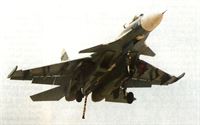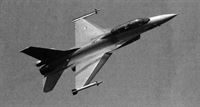Фотографии
-
With tailplane and foreplane leading edges up, this Sukhoi Su-27K is deriving favourable trim for high lift in its landing configuration.
Самолёты на фотографии: Сухой Су-27К / Су-33 - Россия - 1985
-
Although most of the lift is derived from the wing, the forebody (especially with strokes) and centrebody also contribute. Vortices generated at incidence, by the F-16’s leading-edge extension, (seen here during a high-g manoeuvre) interact with the wing leading edge vortex and increase the wing lift.
Самолёты на фотографии: General Dynamics F-16B/D Fighting Falcon - США - 1977
-
Регистрационный номер: R-2113 The predecessor Mirage III, with natural stability, loses lift due to the upwards deflected flaperons needed to trim.
Самолёты на фотографии: Dassault Mirage III - Франция - 1956
-
The relaxed longitudinal stability of the Mirage 2000 allows the wing trailing edge flaperons to be neutral during the landing approach.
Самолёты на фотографии: Dassault Mirage 2000 - Франция - 1978
-
With foreplane deflected fully nose down and wing trailing edge flaperons fully up, the Saab Gripen's landing run is much reduced, without recourse to a braking 'chute. Braking effectiveness is increased due to download on the undercarriage. Aerodynamic drag is provided by the ‘barn door’ foreplane.
Самолёты на фотографии: SAAB Gripen / JAS-39A/C - Швеция - 1988
-
A large tailplane deflection (leading edge down) is needed to achieve and trim the high angle of attack required by the Grumman F-14 Tomcat as it comes off the catapult, full of fuel and at a relatively low speed.
Самолёты на фотографии: Grumman F-14 Tomcat - США - 1970
-
One of the main benefits of the foreplane delta, such as that adopted for the Eurofighter Typhoon, is that it offers especially high supersonic agility. With a suitably positioned centre of gravity, it can also provide particularly high subsonic turn rates.
Самолёты на фотографии: Eurofighter Typhoon / EF-2000 - International - 1994
-
All variable sweep wing aircraft, with high lift flap systems, inevitably employed aft tails. A typical example is the Grumman F-111, the EF-111 electronic warfare variant of which is seen here in formation with the aircraft displaying its full range of wing sweep angles.
Самолёты на фотографии: Grumman EF-111 Raven - США - 1977
-
This wind tunnel model of the Eurofighter concept demonstrator EAP, shows the favourable foreplane/wing flowfield interaction.
Самолёты на фотографии: BAe EAP - Великобритания - 1986
-
A Saab Viggen touching down. The large flap deflection necessary on the foreplane to trim is clearly seen on this canard delta which lacks relaxed stability.
Самолёты на фотографии: SAAB Viggen / AJ.37 - Швеция - 1967
Статьи
- -
- Airscene
- Jet Airliner A to Z
- Talkback
- ??? - Miami Miscellany /Commercial aviation/
- B.Taylor - Military Aircrew Training. What's Next? /Military aviation/ (2)
- D.Baker - Air Transport 2025 /Commercial aviation/
- J.Haynes - All at Sea /Military aviation/
- N.Beckett - Foreplanest Foremost or should the tail wag the dog? /Technology/
- P.Butowski - Kamovs for the Navy /Military aviation/









